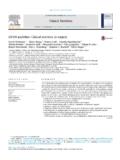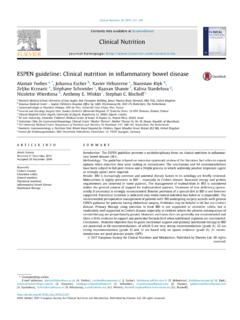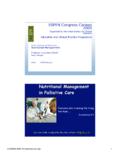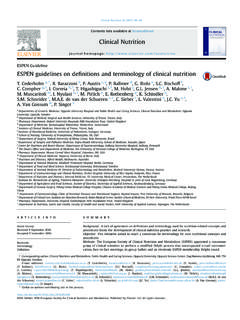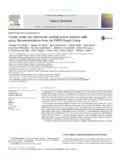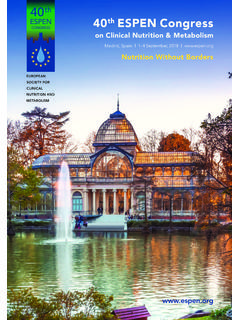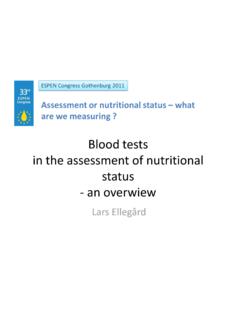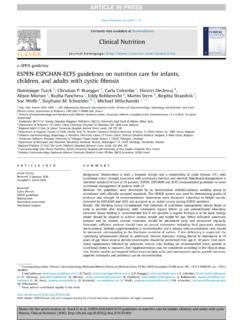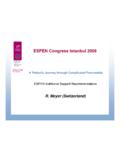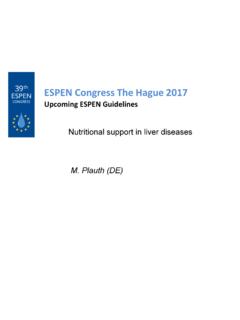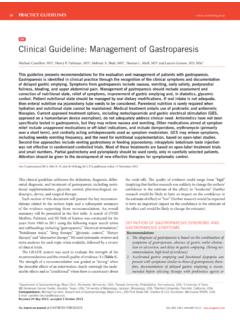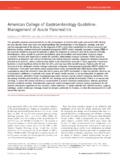Transcription of ESPEN guidelines on nutritional support for …
1 ESPEN guidelines on nutritional support for polymorbid internalmedicine patientsFilomena Gomesa,n,1, Philipp Schuetza,n,*,1, Lisa Bounourea,n, Peter Austinb,Mar a Ballesteros-Pomarc, Tommy Cederholmd, Jane Fletchere, Alessandro Lavianof,Kristina Normang, Kalliopi-Anna Pouliah, Paula Ravascoi, Stephane M. Schneiderj,Zeno Stangak, C. Elizabeth Weekesl, Stephan C. BischoffmaCantonal Hospital Aarau, SwitzerlandbOxford and Southampton University Hospitals, United KingdomcComplejo Asistencial Universitario de Le on, SpaindUppsala University, SwedeneQueen Elizabeth Hospital, Birmingham, United KingdomfSapienza University of Rome, ItalygCharit e University Medicine Berlin, GermanyhLaiko General Hospital of Athens, GreeceiUniversity of Lisbon, PortugaljUniversity of Nice Sophia-Antipolis, FrancekUniversity Hospital and University of Bern, SwitzerlandlGuy's&St.
2 Thomas' NHS Foundation Trust and King's College London, United KingdommInstitute of nutritional Medicine, University of Hohenheim, Stuttgart, GermanynMedical Faculty, University of Basel, Switzerlandarticle infoArticle history:Received 28 June 2017 Accepted 28 June 2017 Keywords:GuidelinesPolymorbidityMultimor bidityNutritional supportHospitalized patientssummaryBackground&aims:Polymorbi dity (also known as multimorbidity)edefined as the co-occurrence of atleast two chronic health conditionseis highly prevalent, particularly in the hospitalized , clinical guidelines largely address individual diseases and rarely account for aim of this project was to develop guidelines on nutritional support for polymorbid patients hos-pitalized in medical :The methodology used for the development of the current project follows the standardoperating procedures for ESPEN guidelines .
3 It started with an initial meeting of the Working Group inJanuary 2015, where twelve key clinical questions were developed that encompassed different aspects ofnutritional support : indication, route of feeding, energy and protein requirements, micronutrient re-quirements, disease-specific nutrients, timing, monitoring and procedure of intervention. Systematicliterature searches were conducted in three different databases (Medline, Embase and the CochraneLibrary), as well as in secondary sources ( published guidelines ), until April 2016. Retrieved abstractswere screened to identify relevant studies that were used to develop recommendations, which werefollowed by submission to Delphi voting :From a total of 4532 retrieved abstracts, 38 relevant studies were analyzed and used to generatea guideline draft that proposed 22 recommendations and four statements.
4 The results of thefirst onlinevoting showed a strong consensus (agreement of>90%) in 68% of recommendations and 75% of state-ments, and consensus (agreement of>75e90%) in 32% of recommendations and 25% of :BI, Barthel Index;bHMB,b-hydroxyb-methylbutyrate; CG, Control Group; DRM, disease-related malnutrition; EN, enteral nutrition; GEB, GuidelinesEditorial Board; IC, indirect calorimetry; IG, Intervention Group; LOS, length of hospital stay; MNA(-sf), Mini nutritional Assessment (short form); NRS 2002, nutritional RiskScore 2002; ONS, oral nutritional supplement(s); PICO, population of interest, interventions, comparisons, outcomes; PN, parenteral nutrition;QoL, quality of life; REE, restingenergy expenditure; RCT, randomized controlled trial; SGA, Subjective Global Assessment; SIGN, Scottish Intercollegiate guidelines Network; TEE, total energy expenditure;WG, Working Group.
5 *Corresponding author. Cantonal Hospital Aarau, Medical Faculty, University of Basel, Tellstrasse H7, 5001 Aarau, Switzerland. Fax 41 Schuetz). and contributed equally to this lists available atScienceDirectClinical Nutritionjournal homepage: 2017 European Society for clinical Nutrition and Metabolism. Published by Elsevier Ltd. All rights Nutrition xxx (2017) 1e18 Please cite this article in press as: Gomes F, et al., ESPEN guidelines on nutritional support for polymorbid internal medicine patients, ClinicalNutrition (2017), thefinal consensus conference, a consensus greater than 89% was reached for all of :Despite the methodological difficulties in creating non-disease specific guidelines , the ev-idence behind several important aspects of nutritional support for polymorbid medical inpatients wasreviewed and summarized into practical clinical recommendations.
6 Use of these guidelines offer anevidence-based nutritional approach to the polymorbid medical inpatient and may improve theiroutcomes. 2017 European Society for clinical Nutrition and Metabolism. Published by Elsevier Ltd. All What is the definition of polymorbidity?Although there is no universally accepted definition of poly-morbidity (also known as multimorbidity), some authors define itas being the co-occurrence of at least two chronic health conditionsin the same person. That is also the definition used for the purposesof this guideline, based on literature recommendations[1e3]anddiscussions within the guideline Working Group (WG).The health and nutrition implications of suffering from morethan one disease at the same time differ from the correspondinginteractions between disease and aging.
7 Polymorbidity is often,but not necessarily, observed in older persons, in contrast to thegeriatric context when multimorbidity is always combined withfunctional limitations and other age-related degenerative expres-sions. As life expectancy increases and individuals acquire a vari-ety of chronic illnesses, polymorbidity becomes one of the mainchallenges that many healthcare and social services question and recommendation(s)/statement(s)Indication 1. Does nutritional support based on screening and/or assessment versus no screening and/or assessment improveoutcomes in polymorbid inpatients?Recommendation polymorbid medical inpatients, a quick and simple nutritional screening method using different validated tools should beapplied to identify malnutrition risk.
8 In patients at risk, a more detailed assessment should be performed and a treatment planshould be developed, to consent an early adequate nutritional therapy and to define quality outcome measures of success.(Grade of recommendation B)estrong consensus (100% agreement)Route of feeding2. In polymorbid inpatients whose nutritional requirements can be met orally, does the use of oral nutritionalsupplements (ONS), with or without nutritional counseling, versus no ONS, improve outcomes?Recommendation malnourished polymorbid medical inpatients or those at high risk of malnutrition who can safely reach their nutritionalrequirements orally, ONS high in energy and protein shall be considered to improve their nutritional status and quality of life.
9 (Grade of recommendation A)estrong consensus (95% agreement)Recommendation malnourished polymorbid medical inpatients or those at high risk of malnutrition, nutrient-specific ONS should beadministered, when they may maintain muscle mass, reduce mortality or improve quality of life.(Grade of recommendation B)econsensus (89% agreement)Recommendation polymorbid medical inpatients who are malnourished or at high risk of malnutrition and can safely reach their nutritionalrequirements orally, ONS should be considered as a cost-effective way of intervention towards improved outcomes.(Grade of recommendation B)estrong consensus (95% agreement)3. In patients where nutritional requirements cannot be met orally, does the use of enteral nutrition (EN)compared to parenteral nutrition (PN) (total or supplemental) result in improved outcomes in polymorbidinpatients?
10 Recommendation polymorbid medical inpatients whose nutritional requirements cannot be met orally, EN can be administered. In thesecases, the use of EN may be superior to PN because of a lower risk of infectious and non-infectious complications.(Grade of recommendation 0)estrong consensus (100% agreement)Energy requirements4. Does the estimation of energy requirements with a prediction equation versus a weight-based formula improveoutcomes of polymorbid inpatients requiring nutritional support ?Recommendation requirements in polymorbid medical inpatients can be estimated using indirect calorimetry (IC), a published predictionequation or a weight-based formula.
